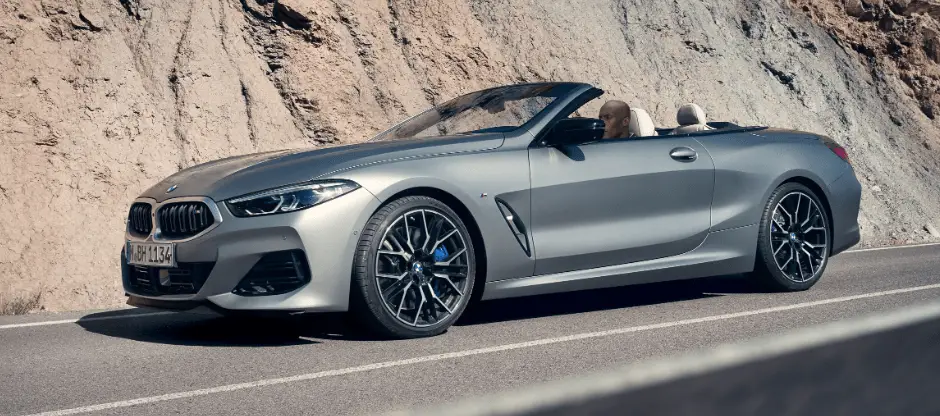BMW 8 Series Convertible 2022-2023 Ice On Window Glass User Manual
Ice On Window Glass
NOTICE
The window will be lowered slightly when pulling on the door handle. In the event of frost, the window may freeze up and not be lowered. There is a risk of damage to property, among other potential damage. When pulling on the door handle, make sure that the window is lowered. If necessary, remove snow and ice from the window. Do not open the door with force.
Hot exhaust gas system
Warning
High temperatures can occur underneath the body, for instance, caused by the exhaust gas system, while driving. Contact with the exhaust gas system can cause burns. There is a risk of injury. Do not touch the hot exhaust gas system, including the exhaust pipe.
Warning
If combustible materials, such as leaves or grass, come in contact with hot parts of the exhaust gas system, these materials can ignite. There is a risk of fire and an injury hazard. Do not remove the heat shields installed and never apply undercoating to them. Make sure that no combustible materials can come in contact with hot vehicle parts while driving, at idle or during parking.
Mobile communication devices in the vehicle
Warning
Vehicle electronics and mobile phones can influence one another. There is radiation due to the transmission operations of mobile phones. There is a risk of injury or risk of damage to property. If possible, in the car’s interior use only mobile phones with direct connections to an external antenna in order to exclude mutual interference and deflect the radiation from the car’s interior.
Aquaplaning
On wet or slushy roads, a wedge of water can form between the tires and the road surface.
This phenomenon is referred to as aquaplaning. It is characterized by a partial or complete loss of contact between the tires and the road surface, ultimately undermining your ability to steer and brake the vehicle.
Driving through water
General information
When driving through water, follow the following:
- Deactivate Auto Start/Stop function.
- Drive through calm water only.
- Drive through water only if it is not deeper than the maximum of 9.8 inches/25 cm.
- Drive through water no faster than walking speed, up to 3 mph/5 km/h.
Safety information
NOTICE
When driving too quickly through too deep water, water can enter into the engine compartment, the electrical system or the transmission. There is a risk of damage to property, among other potential damage. When driving through water, do not exceed the maximum indicated water level and the maximum speed for driving through water.
Braking safely
General information
The vehicle is equipped with an Antilock Braking System ABS as a standard feature.
Perform emergency braking in situations that require such.
Steering is still responsive. You can still avoid any obstacles with a minimum of steering effort.
Pulsation of the brake pedal and sounds from the hydraulic circuits indicate that the Antilock Braking System ABS is in its active mode.
In certain braking situations, the perforated brake discs can emit functional noises. However, functional noises have no effect on the performance and operational reliability of the brake.
Objects in the area around the pedals
Warning
Objects in the driver’s floor area can limit the pedal distance or block a depressed pedal. There is a risk of an accident. Stow objects in the vehicle such that they are secured and cannot enter into the driver’s floor area. Use floor mats that are suitable for the vehicle and can be safely attached to the floor. Do not use loose floor mats and do not layer several floor mats. Make sure that there is sufficient clearance for the pedals. Ensure that the floor mats are securely fastened again after they were removed, for instance for cleaning.
Driving in wet conditions
In case of wet roads, exposure to road salt, in heavy rain, gently press the brake pedal every few kilometers.
Ensure that this action does not endanger other road users.
The heat generated during braking dries brake discs and brake pads and protects them against corrosion.
In this way, braking efficiency will be available when you need it.
Hills
General information
Drive long or steep downhill gradients in the gear that requires the least braking effort. Otherwise, the brake system may overheat and reduce the braking effect.
You can increase the engine’s braking effect by shifting down, and going all the way to first gear if needed.
Safety information
Warning
Light but consistent pressure on the brake pedal can lead to high temperatures, brakes wearing out, and possibly even brake system failure. There is a risk of an accident. Avoid placing excessive stress on the brake system.
Warning
In an idle state or with the engine switched off, safety functions, for instance, engine braking effect, braking assistance and steering assistance may not be available. There is a risk of accident. Do not attempt to drive in an idle state or with the engine switched off.
Brake disc corrosion
Corrosion on the brake discs and contamination on the brake pads are increased by the following circumstances:
- Low mileage.
- Extended periods when the vehicle is not used at all.
- Infrequent use of the brakes.
- Aggressive, acidic, or alkaline cleaning agents.
Corrosion buildup on the brake discs will cause a pulsating effect on the brakes in their response -generally, this cannot be corrected.
Condensation water under the parked vehicle
When using automatic climate control, condensation water develops and collects underneath the vehicle.
Reference Links
View Full User Guide: BMW 8 Series Convertible 2022-2023 User Manual
Download Manuals: https://www.bmwusa.com/owners-manuals.html


